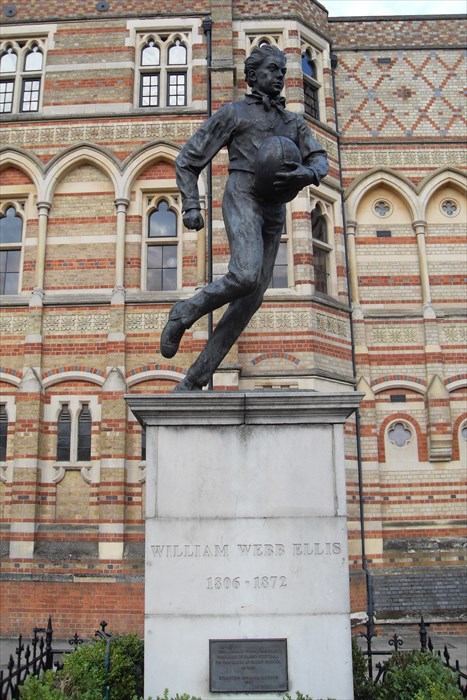2. Before 1872
Games involving a pig's bladder or other similar object had been played throughout the history of mankind and in the early part of the nineteenth century the boys being educated at public schools had developed their own versions of a game with features similar to the games we now know as soccer and rugby. The pupils attending public schools were encouraged to play their games by Headmasters like Thomas Arnold of Rugby School. The novel, "Tom Brown's Schooldays,' by Thomas Hughes, first published in 1857, was very popular and helped to generate interest in the game. The book includes a very clear description of the rules of the football game as played at Rugby School.
The legend of William Webb Ellis picking up the ball and running with it dates from1823 when he was a pupil at Rugby School. If he did pick up the ball and run with it, he either misunderstood the rules of the game at the time or it was a deliberate provocative act for which he would surely have been severely censured.
Several factors came together which allowed the game of rugby football to rapidly develop in the middle of the 19th century. When they left university the young men of the time were keen to continue playing the game in their home towns. By the middle of the nineteenth century railways covered the country and transporting fifteen to twenty young men from one place to another to play their fixtures had never been easier. Working men were given Saturday afternoons off and they looked for ways to spend their new leisure time. This combination of factors helped the game to grow and develop.
In 1857 in the North a Mr. Mather of Bootle Hall, Liverpool, wrote to many ex-Public School men in the region and invited them to journey to Edge Hill, Liverpool, shortly before Christmas to experiment with the new football game which had come from Rugby School. The verdict was favourable and these men and others commenced playing games in Manchester and Liverpool, though the clubs were not started for some years. So much did the game prosper in Lancashire that the first county fixture against Yorkshire was played in1870.
Interest in rugby throughout the country must also have been considerable in the 1860's and 1870's as many clubs were established during this period and this culminated in the formation of the Rugby Football Union (RFU) on 26th January 1871, when 32 representatives of 21 rugby clubs, all from the London area, met at the Pall Mall Restaurant in London. Algernon Rutter was elected as President and a committee was formed. Its first task was to agree a set of laws and the version adopted at Rugby School was adopted. Until 1863 there had been one single game, which incorporated aspects of both the games we now know as soccer and rugby and these included hacking and tripping. Some of those attending the meeting wanted to remove the hacking and tripping along with the handling and this became the basis of the game we now know as soccer. The Blackheath Club attended this meeting and refused to agree to these changes as they wished to retain both hacking and handling which was very much inline with the laws used at Rugby School.
On the 27th March 1871 the newly formed RFU accepted a challenge from a combination of leading Scottish Football Clubs (clubs playing rugby continued to be known as football clubs), for an international rugby match to be played at Raeburn Place, Edinburgh. Seven out of the twenty players in the England side were represented by players from the Manchester or Liverpool clubs, all the others coming from London.
The object of the game in the 1870's was to set up a situation whereby the ball could be kicked between the goal posts and over the crossbar. In order to achieve this, each team would attempt to make progress towards the opposition goal line. If the ball was moved over the goal line the team could take a kick at goal. A kick from anywhere on the field was known as a field goal. The result was decided on the number of goals scored; tries would only be used a few years later. The game being played at this time mainly involved kicking the ball with the feet but play also involved scrummages and rucks, which could last for several minutes. Refereeing of the game in the early years was done by the captains of each team, which meant that "disputed tries' were common.
As mentioned at this time the number of players in a team could be varied up to 20. The Captains before the game would agree the numbers in each team. This allowed for a handicap system when one team was known to be stronger than the other. Moustaches and beards were apparently fashionable at the time. The boots did not have studs but some players would attach strips of leather to the soles to improve the grip, this was known as "barring the boots.'
Against this backdrop, nearly fifty years after William Webb Ellis was reputed to have run with the ball and ironically in the year he died (see Club Trivia), the time was right for Southport and Birkdale as growing townships with many ex-public school boy residents to form a club to formally play the game which had become commonly known as rugby after the school whose rules it adopted.


